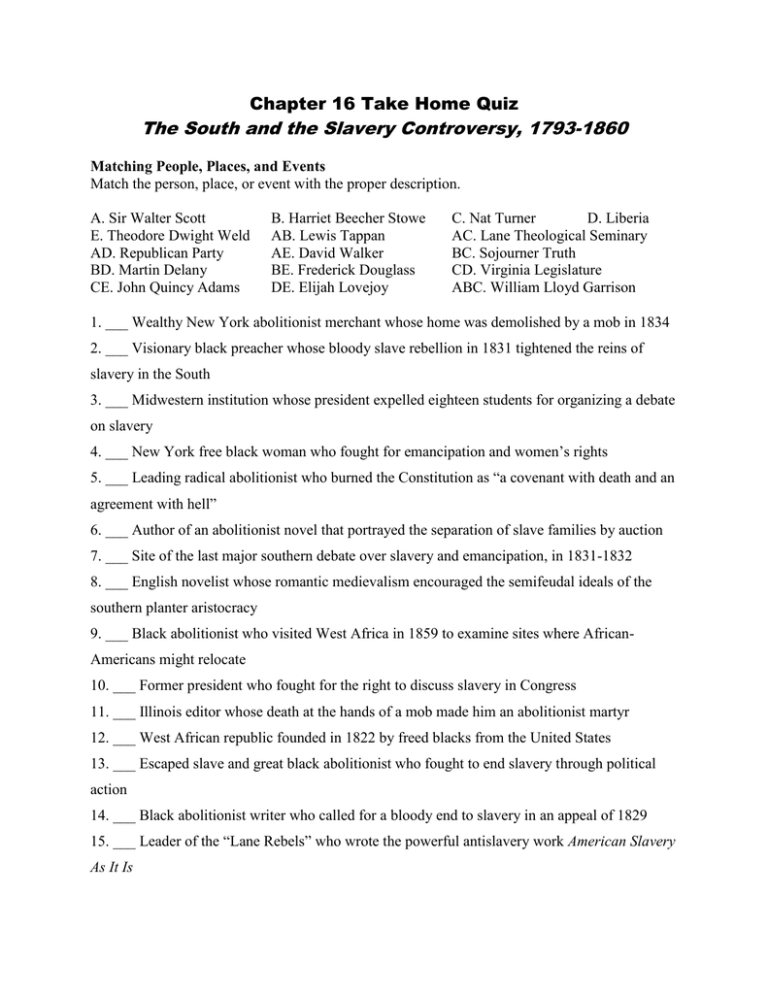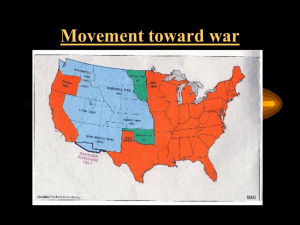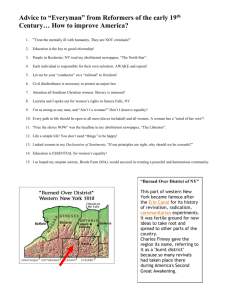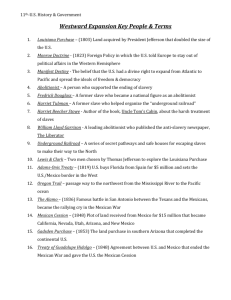Chapter 16 Take Home Quiz The South and the Slavery Controversy
advertisement

Chapter 16 Take Home Quiz The South and the Slavery Controversy, 1793-1860 Matching People, Places, and Events Match the person, place, or event with the proper description. A. Sir Walter Scott E. Theodore Dwight Weld AD. Republican Party BD. Martin Delany CE. John Quincy Adams B. Harriet Beecher Stowe AB. Lewis Tappan AE. David Walker BE. Frederick Douglass DE. Elijah Lovejoy C. Nat Turner D. Liberia AC. Lane Theological Seminary BC. Sojourner Truth CD. Virginia Legislature ABC. William Lloyd Garrison 1. ___ Wealthy New York abolitionist merchant whose home was demolished by a mob in 1834 2. ___ Visionary black preacher whose bloody slave rebellion in 1831 tightened the reins of slavery in the South 3. ___ Midwestern institution whose president expelled eighteen students for organizing a debate on slavery 4. ___ New York free black woman who fought for emancipation and women’s rights 5. ___ Leading radical abolitionist who burned the Constitution as “a covenant with death and an agreement with hell” 6. ___ Author of an abolitionist novel that portrayed the separation of slave families by auction 7. ___ Site of the last major southern debate over slavery and emancipation, in 1831-1832 8. ___ English novelist whose romantic medievalism encouraged the semifeudal ideals of the southern planter aristocracy 9. ___ Black abolitionist who visited West Africa in 1859 to examine sites where AfricanAmericans might relocate 10. ___ Former president who fought for the right to discuss slavery in Congress 11. ___ Illinois editor whose death at the hands of a mob made him an abolitionist martyr 12. ___ West African republic founded in 1822 by freed blacks from the United States 13. ___ Escaped slave and great black abolitionist who fought to end slavery through political action 14. ___ Black abolitionist writer who called for a bloody end to slavery in an appeal of 1829 15. ___ Leader of the “Lane Rebels” who wrote the powerful antislavery work American Slavery As It Is More Matching… A. American Slavery As It Is E. Cotton Kingdom AD. Free Blacks BD. Lane Rebels B. Lord of the Loom C. Gag Rule D. Liberator AB. Free Soilers AC. American Anti-Slavery Society AE. Black Belt BC. American Colonization Society BE. Second Great Awakening CD. Hillbillies 16. ___ Term for the South that emphasized its economic dependence on a single staple product 17. ___ Prosouthern New England textile owners who were economically tied to the southern “lords of the lash” 18. ___ Derogatory term for the most economically deprived southern whites; also called “crackers” or “clay eaters” 19. ___ The poor, vulnerable group that was the object of prejudice in the North and despised as a “third race” in the South 20. ___ Theodore Dwight Weld’s powerful antislavery work 21. ___ The area of the South where most slaves were held, stretching from South Carolina across to Louisiana 22. ___ Organization founded in 1817 to send blacks back to Africa 23. ___ The group of students, led by Theodore Dwight Weld, who were expelled from their seminary for abolitionist activity and later became leading preachers of the antislavery gospel 24. ___ William Lloyd Garrison’s fervent abolitionist newspaper that preached an immediate end to slavery 25. ___ Garrisonian abolitionist organization, founded in 1833, that included the eloquent Wendell Phillips among its leaders 26. ___ Strict rule passed by prosouthern Congressmen in 1836 to prohibit all discussion of slavery in the House of Representatives 27. ___ Northern antislavery politicians, like Abraham Lincoln, who rejected radical abolitionism but sought to prohibit the expansion of slavery in the western territories Multiple Choice Select the best answer for each of the following questions. 28. ___ As a result of the introduction of the cotton gin, a. fewer slaves were needed on the plantations b. short-staple cotton lost popularity c. slavery was reinvigorated d. Thomas Jefferson predicted the gradual death of slavery 29. ___ Members of the planter aristocracy a. produced fewer front-rank statesmen than the North b. had a keen sense of obligation to serve the public c. provided democratic rule in the South d. promoted tax-supported public education 30. ___ Plantation agriculture a. led to a slow return on investments b. remained diverse until the Civil War c. was wasteful d. discouraged immigration to the west 31. ___ The plantation system of the cotton South was a. increasingly monopolistic b. efficient at utilizing natural resources c. financially stable d. attractive to European immigrants 32. ___ All of the following were weaknesses of the slave plantation system except a. it relied on a one-crop economy b. it repelled a large-scale European immigration c. it lost significant numbers of people to the west d. its land continued to remain in the hands of the small farmers 33. ___ The mistress of the plantation a. had little contact with slaves b. primarily controlled male slaves c. frequently supported abolitionism d. commanded a sizable household staff of mostly female slaves 34. ___ Most white southerners were a. planter aristocrats b. small slaveowners c. nonslaveowning subsistence farmers d. “poor white trash” 35. ___ By the mid-nineteenth century, a. most southerners owned slaves b. the smaller slaveholders owned a majority of the slaves c. most slaves lived on large plantations d. slavery was a dying institution 36. ___ The group in the South owning the most slaves was a. subsistence farmers b. mountain whites c. plantation owners d. small farmers 37. ___ The majority of southern whites owned no slaves because a. they opposed slavery b. they could not afford the purchase price c. their urban location did not require them d. their racism would not allow them to work alongside the African-Americans 38. ___ The most pro-Union of the white southerners were a. “poor white trash” b. mountain whites c. small slaveowners d. nonslaveowning subsistence farmers 39. ___ Some Southern slaves gained their freedom as a result of all of the following except a. the wave of emancipation after the War of 1812 b. an idealism inspired by the Revolution c. being the children of white masters d. purchasing their freedom 40. ___ The great increase of the slave population in the first half of the nineteenth century was largely due to a. the reopening of the African slave trade in 1808 b. larger imports of slaves from the West Indies c. natural reproduction d. reenslavement of free blacks 41. ___ Northern attitudes towards free blacks can be best described as a. supporting their right to full citizenship b. disliking the race but liking individual blacks c. advocating black movement into new territories d. very racist 42. ___ For free blacks living in the North, a. living conditions were nearly equal to those for whites b. voting rights were widespread c. good jobs were plentiful d. discrimination was common 43. ___ Perhaps the slave’s greatest horror, and the theme of Harriet Beecher Stowe’s Uncle Tom’s Cabin, was a. the separation of slave families b. the frequent use of the whip by slaveowners c. the breeding of slaves d. slaves always having to do the most dangerous work on the plantation 44. ___ Forced separation of spouses, parents, and children was most common a. in the deep South b. on the large plantations c. on small plantations and in the upper South d. in the decade prior to the Civil War 45. ___ Most slaves were raised a. without the benefit of a stable home life b. never knowing anything about their relatives c. without religion d. in stable two-person households 46. ___ Slaves fought the system of slavery in all of the following was except a. slowing down the work pace b. refusing to get an education c. sabotaging expensive equipment d. pilfering goods their labor had produced 47. ___ One result of white Southerners’ brutal treatment of their slaves and their fear of potential slave rebellions was the a. development of a theory of biological racial superiority b. adoption of British attitudes towards the “peculiar institution” c. emancipation of many slaves d. South’s shedding its image as a reactionary backwater 48. ___ The idea of transporting blacks back to Africa was a. proposed by William Lloyd Garrison b. never carried out c. the result of the widespread loathing of blacks in America d. suggested by the African nation of Liberia 49. ___ Match the abolitionist with his role in the movement A. Wendall Phillips 1. abolitionist martyr B. Frederick Douglass 2. black abolitionist C. Elijah P. Lovejoy 3. abolitionist orator D. William Lloyd Garrison 4. abolitionist financier a. A-4, B-2, C-1 b. A-1, B-4, C-2 c. A-3, B-2, C-1 d. A-2, B-1, C-4 50. ___ Many abolitionists turned to political action in 1840 when they backed the presidential candidate of the a. Free Soil Party b. Republican Party c. Know-Nothing Party d. Liberty Party Essay: No, you do not need to write an essay, but on the back of your mastery manager sheet, please prepare a detailed outline for this question including the namedrops you would use. 20 pts Question: Analyze the ways in which supporters and opponents of slavery in the nineteenth century used legal, religious, and economic arguments to defend or attack the institution of slavery.




